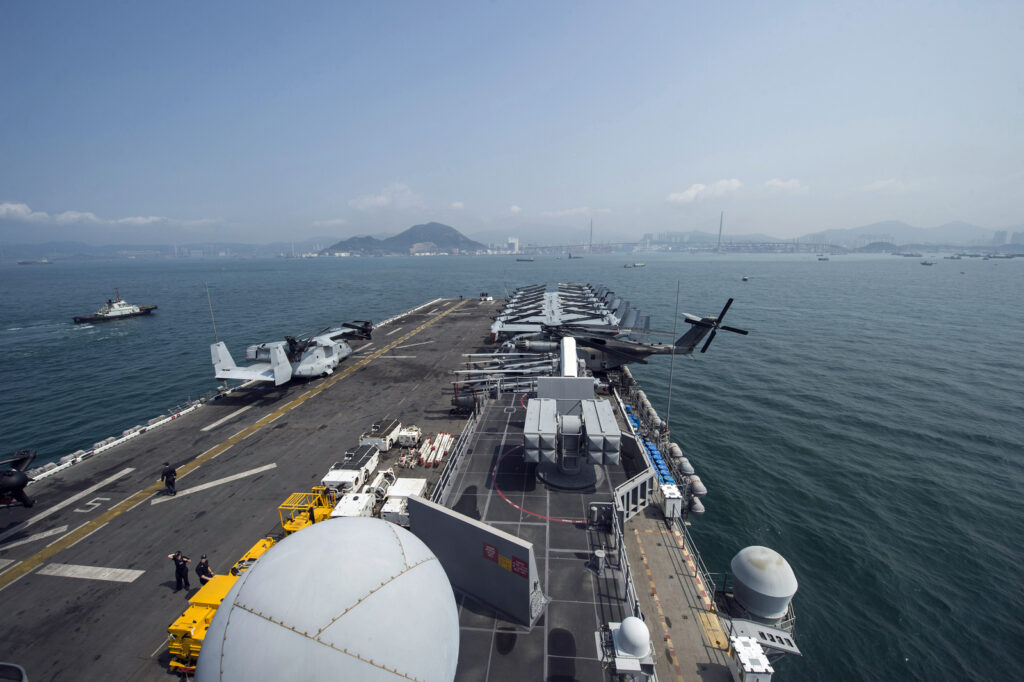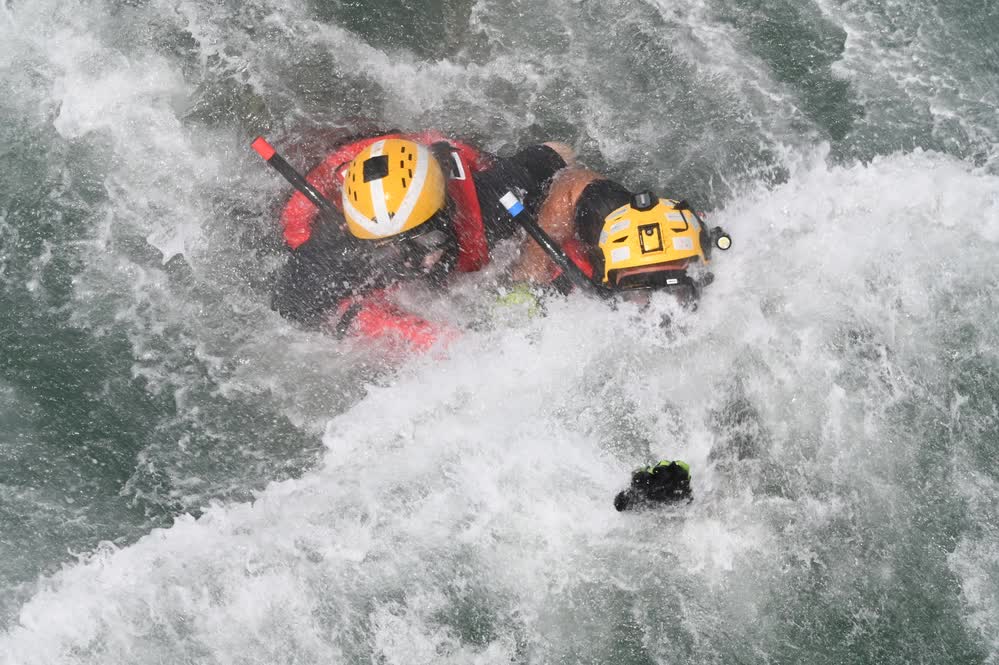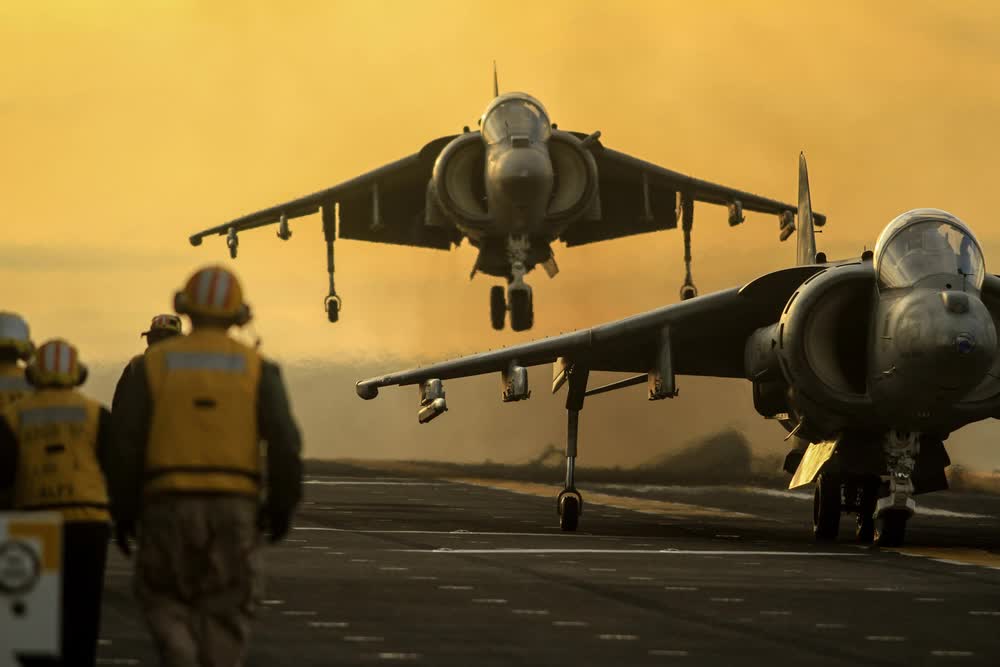This article by Michael D. Purzycki was originally published by Divergent Options.
Michael D. Purzycki is an analyst, writer, and editor based in Arlington, Virginia. He has worked as a communications and media analyst for the United States Marine Corps and a technical writer for the Department of the Navy. In addition to Divergent Options, he has been published in Charged Affairs (the journal of Young Professionals in Foreign Policy), Merion West, Braver Angels, the Washington Monthly, France 24, the Truman National Security Project, and Arc Digital. He can be found on Twitter at @MDPurzycki and on Medium at https://mdpurzycki.medium.com/. Divergent Options’ content does not contain information of an official nature nor does the content represent the official position of any government, any organization, or any group.
National Security Situation: China and Russia pose threats to U.S. interests and allies. While the Biden administration seeks to deemphasize military force relative to other aspects of U.S. power, only a credible deterrence, including an appropriately sized and based maritime capability, can enable maximal use of America’s non-military strengths.
Date Originally Written: April 16, 2021.
Date Originally Published: May 3, 2021.
Author and / or Article Point of View:This article is written from the perspective of U.S. policymakers who seek to prepare the United States for the maritime aspect of large-scale combat operations with China and/or Russia. These policymakers are constrained by limited industrial and shipyard capacities, a shortage of Americans fit to serve, and probable cuts to military spending.
Background: The U.S. defense industrial base is in decline[1]. The Navy’s public shipyards are unable to meet its repair needs[2][3]. The COVID-19 pandemic made nearly a quarter of the shipyards’ workforce “unable to come in to work due to being deemed ‘high risk[4].’” Data released by the U.S. Department of Defense in 2017 found 71% of Americans ages 17 to 24 would not qualify for military service, largely due to obesity, inadequate education, and criminal records[5]. Defense spending is likely to fall in the coming years. All these problems curtail the Navy and Marine Corps’ ability to respond quickly to emerging threats and crises.
Greater use of unmanned vessels offers a partial solution to manning problems. However, unmanned technology is still in its early stages, and the rapid cost increases of the F-35 and the Littoral Combat Ship are warnings not to scale up any major system too quickly[6][7].
Significance: While increased investment by European and Indo-Pacific allies in their own militaries would greatly help the U.S., basing more U.S. vessels in allied ports would make clear America’s commitment to its allies’ security. Meanwhile, the stated wish of Commandant of the Marine Corps General David H. Berger to reduce reliance on “legacy” systems and large numbers of personnel provides an opportunity to experiment with smaller, more mobile Marine units[8].
Option #1: The U.S. bases more vessels at locations closer to its great power competitors, and seeks new ports to host them.
Risk: Increasing the number of U.S. vessels close to China and/or Russia may increase the sense of insecurity both countries feel. China and/or Russia may respond by attempting to base their own vessels in the Western Hemisphere. The March 2021 case of Argentina refusing a U.S. Coast Guard cutter the right to dock in its ports illustrates China’s influence in the South Atlantic: China has made major investments in Argentina’s energy and transportation infrastructure, and a Chinese company operates Brazil’s second-largest container port[9]. The fact that Argentina and Brazil are both Major Non-North Atlantic Treaty Organization (NATO) Allies (MNNAs) of the U.S. does not mean they will not align with China on certain issues; Pakistan, also an MNNA, has long been a military partner of China due to the countries’ shared rivalry with India[10].
Increased forward basing may strain the Navy in some ways. In his award-winning 2018 essay for Proceedings, “How We Lost the Great Pacific War,” Captain Dale Rielage details how the U.S. could lose a major conflict in part by increasing forward deployment of vessels without maintaining enough vessels at home[11]. The importance of the total number of each type of vessel must not be forgotten.
Gain: A greater number of vessels at a greater number of bases near China and Russia would give the U.S. more flexibility in responding to challenges. A 2017 study by the Center for Strategic and Budgetary Assessments suggested South Korea and the United Kingdom as possible new locations, as well as increasing the number of ships based in Guam, Japan, and Spain[12]. The announcement in 2020 that USS Hershel ‘Woody’ Williams would be based in Souda Bay makes Greece another potential host[13].
Increased forward basing at more locations also provides a hedge against possible threats to U.S. overseas bases from criticism and discontent by locals. For example, local opposition to the Marine Corps presence in Okinawa[14] has influenced the decision to move some Marine units based there to Guam[15]. If, to take one hypothetical example, Spanish political and public opinion turned against the presence of U.S. guided missile destroyers in Rota, Spain, then Souda Bay could provide an alternative location (although this, in turn, could strain already tense U.S.-Turkish relations)[16].
Option #2: The Marine Corps reduces the size of its Marine Expeditionary Units (MEUs).
Risk: Depending on what sorts of conflict a MEU is deployed to, a smaller MEU may be less well suited than a larger one. Even if tanks are not necessary, it is plausible that, if a MEU’s Amphibious Ready Group (ARG) includes an LHA or LHD with fighters, it will fare better in a particular scenario than if it had come without fighters.
Gain: With General Berger seeking to divest all the Marine Corps’ tanks and reduce its reliance on large vessels for amphibious operations[17], a smaller MEU, either in Marine Corps manpower or in the size of the ARG, is worth exploring. Fewer Marines, perhaps carried on fewer ships and aircraft, could deploy more quickly, making it easier for the U.S. to respond to crises. Scaling down the MEU so all its personnel and equipment could fit on one or two amphibious transport docks[18] could also free up amphibious assault ships, specifically the LHA/LHD, to serve as “lightning carriers,” giving the U.S. another option for sea-based airstrikes in addition to large aircraft carriers[19].
Other Comments: None.
Recommendation: None.
Endnotes:
[1] Tadjdeh, Yasmin. “Report Finds U.S. Defense Industrial Base in Decline.” National Defense, February 5, 2020. https://www.nationaldefensemagazine.org/articles/2020/2/5/defense-industrial-base-earns-c-grade-in-new-report
[2] Hooper, Craig. “The US Needs a New Public Shipyard.” Defense One, January 16, 2019. https://www.defenseone.com/ideas/2019/01/us-needs-new-public-shipyard/154221/
[3] Weisberger, Marcus. “As Navy Pushes for More Ships, Experts Warn Repair Yards Are Crumbling.” Defense One, September 30, 2020. https://www.defenseone.com/business/2020/09/navy-pushes-more-ships-experts-warn-repair-yards-are-crumbling/168905/
[4] Werner, Ben. “Navy Calling Up 1,600 Reservists to Fill in For Shipyard Workers Out for COVID-19.” USNI News, June 11, 2020. https://news.usni.org/2020/06/11/navy-calling-up-1600-reservists-to-fill-in-for-shipyard-workers-out-for-covid-19
[5] Heritage Foundation. “The Looming National Security Crisis: Young Americans Unable to Serve in the Military.” February 13, 2018. https://www.heritage.org/defense/report/the-looming-national-security-crisis-young-americans-unable-serve-the-military
[6] Insinna, Valerie. “Inside America’s Dysfunctional Trillion-Dollar Fighter-Jet Program.” New York Times, August 21, 2019. https://www.nytimes.com/2019/08/21/magazine/f35-joint-strike-fighter-program.html
[7] Roblin, Sébastien. “The Navy spent $30B and 16 years to fight Iran with a littoral combat ship that doesn’t work.” NBC News, July 19, 2019. https://www.nbcnews.com/think/opinion/navy-spent-30b-16-years-fight-iran-littoral-combat-ship-ncna1031806
[8] “Commandant’s Planning Guidance: 38th Commandant of the Marine Corps.” https://www.hqmc.marines.mil/Portals/142/Docs/%2038th%20Commandant%27s%20Planning%20Guidance_2019.pdf?ver=2019-07-16-200152-700
[9] Espach, Ralph. “A New Great Game Finds the South Atlantic.” War on the Rocks, March 22, 2021. https://warontherocks.com/2021/03/a-new-great-game-finds-the-south-atlantic/
[10] Blank, Jonah. “Pakistan and China’s Almost Alliance.” RAND Corporation, October 16, 2015. https://www.rand.org/blog/2015/10/pakistan-and-chinas-almost-alliance.html
[11] Rielage, Captain Dale, U.S. Navy. “How We Lost the Great Pacific War.” Proceedings, May 2018. https://www.usni.org/magazines/proceedings/2018/may/how-we-lost-great-pacific-war
[12] Clark, Bryan, Peter Haynes, Jesse Sloman, Timothy A. Walton. “Restoring American Seapower: A New Fleet Architecture for the United States Navy.” Center for Strategic and Budgetary Assessments, February 9, 2017. https://csbaonline.org/research/publications/restoring-american-seapower-a-new-fleet-architecture-for-the-united-states-
[13] Becatoros, Elena (The Associated Press), and Derek Gatopoulos (Associated Press). “Pompeo says USS Hershel ‘Woody’ Williams will be based at Souda Bay.” Navy Times, September 29, 2020. https://www.navytimes.com/news/your-navy/2020/09/29/pompeo-says-uss-hershel-woody-williams-will-be-based-at-souda-bay/
[14] Congressional Research Service. “U.S. Military Presence on Okinawa and Realignment to Guam.” April 9, 2019. https://crsreports.congress.gov/product/pdf/IF/IF10672/3
[15] United States Marine Corps. “Marine Corps Activates Camp Blaz in Guam.” October 1, 2020. https://www.marines.mil/News/News-Display/Article/2367980/marine-corps-activates-camp-blaz-in-guam/
[16] Jakes, Lara. “U.S. Will Base Mammoth Ship in Greece, Near Disputed Territory.” New York Times, October 1, 2020. https://www.nytimes.com/2020/09/29/us/politics/greece-turkey-us-navy.html
[17] “Commandant’s Planning Guidance: 38th Commandant of the Marine Corps.”
[18] Waddell, Major Joshua C., U.S. Marine Corps. “Rethink the MEU for Tomorrow’s Expeditionary Operations.” Proceedings, April 2020. https://www.usni.org/magazines/proceedings/2020/april/rethink-meu-tomorrows-expeditionary-operations
[19] Eckstein, Megan. “Marines Test ‘Lightning Carrier’ Concept, Control 13 F-35Bs from Multiple Amphibs.” USNI News, October 23, 2019. https://news.usni.org/2019/10/23/marines-test-lightning-carrier-concept-control-13-f-35bs-from-multiple-amphibs
Feature image: U.S. Navy photo by Mass Communication Specialist 3rd Class Devin M. Langer




